


|

|
www.cjtu.org |
March 2024 |
General MeetingTuesday, March 12th, 2024Fritz Miller
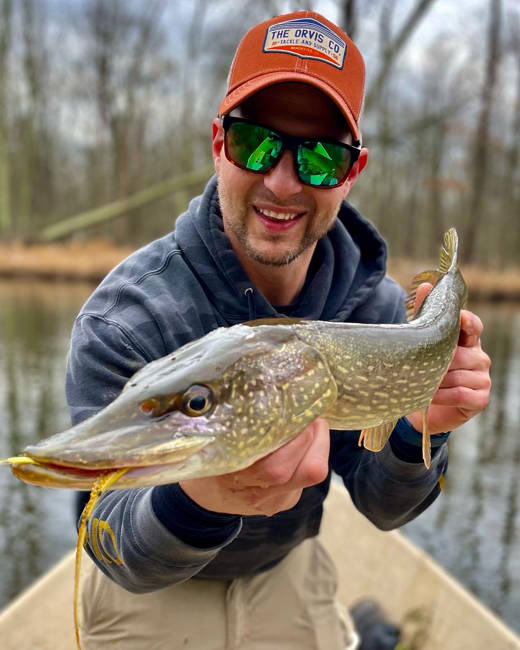
Fritz will take us through the anatomy of a pike, understanding how they feed, using that information to: Fishing and the outdoors have deep roots in Fritz Miller’s family life. As Fritz describes it “ I’ve had a rod in my hand and been on a boat for as long as I can remember. I grew up along the Delaware River in Florence and spent majority of my time fishing for anything that swims along its banks. The summers were usually spent down in LBI seine netting minnows, catching fluke, stripers, blues, and crabs from sunup to sun down. Fly fishing didn’t come until a little bit later in life, around the age of 18 and it’s been my passion ever since. Second to being on the water is sitting behind a vise. I spent almost every ounce of free time perfecting patterns, creating my own, or trying to create the perfect fly for the perfect situation. Over the past few years, guiding has been one of my favorite past times as I am a teacher at heart. I recently acquired my captains license to help teach the art of fly fishing, not only on streams for trout but for stripers and toothy critters that inhabit our waters “. Tuesday, June 11th, 2024Annual Picnic MeetingMeeting LocationAmerican Legion Hall
|
President’s Letter
When I arrived home from the Fly Fishing Show in Lancaster, PA, this Sunday, I heard Spring Peeper frogs singing in the wetlands around my home for the first time this year. The song of these amphibians is a sign that spring is near. It usually also means that warmer weather and better fishing are right around the corner. However, with our mild winter, the fishing has been great since the beginning of the year. I encountered good hatches of midges, little black stoneflies, and blue-wing olives in February, and that activity should continue through early March. The rivers are up due to recent rains, but that is the norm for this time of year. If the warming trend continues, we may even see some larger mayflies and even some early caddis activity by the end of the month. If you live near a trout stream, keep an eye on those forsythias in the neighborhood. Those yellow flowers often indicate that conditions are ripe for a Hendrickson hatch when they bloom. We had ten students in our fly tying class last month, four of whom took up fly-tying for the first time. Everyone enjoyed this year's course of instruction. Unfortunately, I could not participate as an instructor this year as I was conducting classes for Orvis in Princeton on the same weekends. There has been a renewed interest in fly tying in recent years, and our chapter offers some of the best instruction available. Our fly tiers are some of the best in the area. Unfortunately, the only two significant weather events occurred on the days of our monthly meetings, which resulted in both the January and February meetings being canceled. If the stars realign, we will meet next Tuesday for the first time this year. Our March meeting will feature a good friend, Fritz Miller, who will give a presentation on Fly Fishing for Northern Pike in New Jersey. Fritz and I work together at Orvis and as guides for South Branch Outfitters. He is an experienced angler and talented fly tier who has unlocked some of the secrets of fishing for these toothy predators in New Jersey. If you have ever thought about fly fishing for pike, you will want to attend this presentation. At our next few meetings, we will be conducting a fly sale. We still have a large number of flies that we used as a fundraising method several years ago. The flies are coming out of storage and will be available for purchase at our meetings. This sale will be a great way to fill those fly boxes before the season begins. Soon, we will also be offering fur selections for the fly tiers in the group. One of our members donated a large assortment of furs to the chapter. These furs have been sorted but still need to be cut up and packaged for sale. We will likely be doing this work before a general meeting. If you want to help out, drop me a line, and I will keep you informed when we will be working on this project. Looking forward to April, our annual fly tying night, which was rescheduled from January, will take place. Several of our talented fly tiers will be on hand to demonstrate some of their favorite patterns. If you tie flies, you are welcome to bring your vise and tools along and join in. I'll share more information in next month's newsletter. We have a few events on the calendar in the coming months. We will do some restoration work at the Burnt Mills tract on the Lamington River sometime in March. The trees we planted after the dam removal at that location need a little TLC. We will seek volunteers to help replant and restore some trees damaged during recent high-water events. A tentative date of Friday, March 22, is being considered. We will have a sign-up sheet for those interested in helping at the meeting. Check for an Action Alert email once the details are sorted out. Our first stocking of Point Mountain is set to take place on March 18. Ed Kordyla has a short article about the program in this month's newsletter. Our volunteers stock the length of this particular regulation water, ensuring that fish are evenly distributed throughout the tract instead of being dropped off at the bridges crossing the river. If you want to help us stock this stretch of stream, contact the program coordinator, Ed Kordyla, at edward.kordyla@aol.com. On the last Saturday of March, we will be attending Rutgers Day. This event is an opportunity to expose the public to our conservation work in this state. We will be set up at the event to educate folks about Trout Unlimited and give free casting lessons to anyone interested. We are seeking volunteer support for this event, so please lend a hand. You can email me at president@cjtu.org, and I will gladly give you more information about the event. On Saturday, April 13, 2024, we will participate in a river clean-up at Point Mountain on the Musconetcong River. We will meet on the river at 9:00 a.m. and work for a few hours cleaning up the area. The clean-up is a family-friendly event and an excellent opportunity to get outdoors and do something good for the environment! Contact Masha Benovengo at casabeno@msn.com for more information or to sign up for the event. Our annual BBQ is scheduled for June 11, 2024. We are still working out the details and the menu. The BBQ committee will have an update for us soon. As part of the afternoon's festivities, I am working on having a few of the new Orvis Helios fly rods on hand for anyone who would like to cast one of these new state-of-the-art rods. I will also bring up a kayak rigged for fly fishing, float tubes, and a pontoon boat to introduce folks to an exciting way to fly fish during the warmer months. We are still seeking volunteers to serve on the current Board of Directors, which is the group of individuals responsible for running the organization's day-to-day operations. We have several vacant positions that need to be filled. I am happy to discuss what is involved and what is expected of someone who decides they would be interested in helping out. Don't hesitate to contact me at president@cjtu.org if you are interested. I look forward to seeing you (in person) at our next general meeting on Tuesday, March 12, at the American Legion Hall in Dunellin, NJ. Please join us for an evening of conservation, camaraderie, and fishing!
Tight Lines You can contact Bart at president@cjtu.org |
News & EventsMusky River Clean-upSaturday, April 13, 2024Califon TroutfestSaturday, April 20, 2024Rutgers DaySaturday, April 27, 2024Point Mountain Stocking
We will also be stocking the stretch on the following dates: Friday, April 26th - 310 fish, Friday, May 17th - 190 fish, and Friday, May 24th - 190 fish. We meet at the Point Mountain parking lot at 8:00 AM and wait for the hatchery truck. It usually takes about three hours and since the stretch is a trout conservation area we can fish right after we stock - catch and release only. Ed Kordyla, CJTU stocking coordinator 2024 Fly Tying SchoolCentral Jersey TU's 2024 Fly Tying School was held in February and it was another great class. Many thanks to Lou DiGena and Ed Kordyla who were the instructors for the beginners classes and to John Wester, Logistics Coordinator. We hope to see everyone in next years classes! 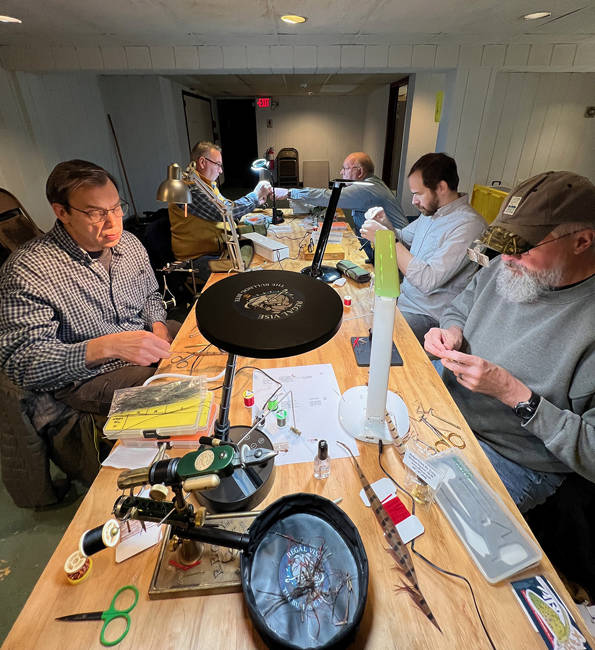
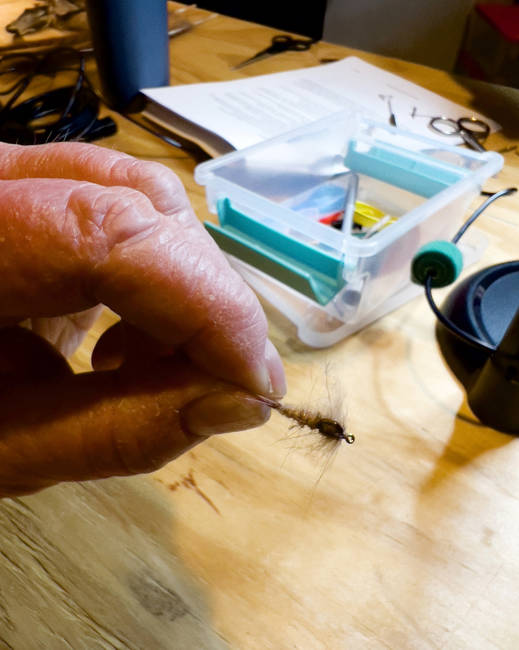
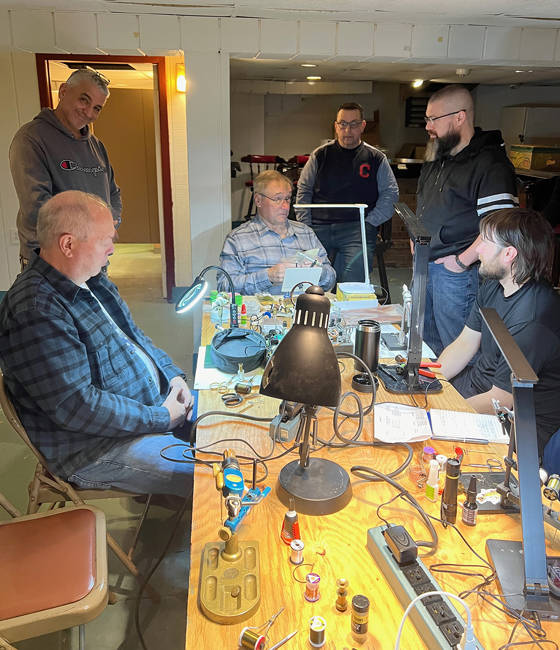
Photos by Lou DiGenaFly of the MonthBair’s No-See-UmTied by Bill Ninke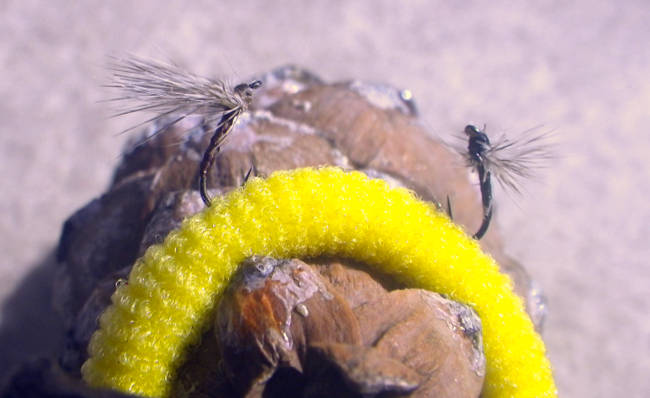
Left, No. 18 Baetis. Right, No. 20 Midge. Flies oriented as they will ride in the water.With the warm weather we’ve had at the end of February and the projected extension into March, small flies (Midges and Baetis) should soon be popping giving us a chance for dry fly fishing after a Winter of dredging. This month’s pattern is a simple combination of a standard dry fly hook, thread and hackle. It can be tied with black thread and grizzly hackle on a size 20 to 24 hook to represent a midge. Tied with olive thread on a 18 to 22 hook and either grizzly or dun hackle, it represents a Baetis. With these simple attributes you might think it was created by a guide. But this pattern is the design of Phil Bair, just a dedicated fly fisher from Utah. He does have the local reputation, however, of someone you should not fish behind. While I’m showing the pattern as a Midge and a Baetis, you can vary the hackle and thread colors to create versions to imitate Sulfurs, PMDs, Paraleps and other small mayflies. From the photo above, you might recognize the wing creation technique. It’s just a collar of five turns of hackle with “X” wraps of thread underneath to bring all the fibers above the hook shank. Guess you could call it a hackle fiber Comparadun wing. This is an old technique that Datus Proper introduced in his 1982 book “What the Trout Said”. So if the key technique is from long ago and the wing resembles that of a Comparadun, also an old pattern, what justifies the new name and attribution to Bair? Look at the above photo of the pattern. What do you see, or more to the point, what do you not see? That’s right, there is no tail. As a result the wing doesn’t sit upright poking above the water as we normally expect of a wing. Instead the wing sits mired flat in the surface film and the thin thread body hangs down below the surface. This gives the trout a direct view of what’s coming long before the mired wing pops up in the “window”. Forewarned is fore eaten. You want the pattern to float in the film. Since the pattern is held there by the mired hackle fibers, the hold is stronger with longer fibers. So for flies to be fished in flat water, use a hackle that is two sizes larger than normal for the hook. For example, use a size 16 hackle on a size 20 hook. For flies to be fished in turbulent water, use a hackle that is three sizes larger than normal for the hook. For example use a size 14 hackle on a size 20 hook. Don’t use powder floatants with this pattern. It will get on the body which you want to sink. Use a paste floatant on the wing only. Even with careful tying, treatment and casting, the pattern can sink a bit. But with the sparse natural profile trout still readily eat it. Since, during the drift after being cast out, the tiny pattern can be mired in the film or slightly submerged, the appropriateness of the No-See-Um name is apparent. So how can you know where it is? I recommend fishing this pattern as a duo with a larger white post parachute dry fly. I often use a size 14 Parachute Adams. If you want to fish just this pattern, add a small section of a paste-on foam indicator or a New Zealand Strike Indicator a few feet about this pattern. Small size tippet (6X) helps in keeping your float drag free. You get sips not slashes with this pattern so just gently lift to set the hook and be ready for a quick initial run. Tying instructions for how I tie the fly are given below. You can also view how two noted tiers, Clark “Cheech” Pierce and Barry Ord Clarke tie it at https://www.youtube.com/watch?v=vImm4b4sdYE&t=5s and https://www.youtube.com/watch?v=ZnV8nsO0VOY respectively. You can send comments, questions and suggestions to Bill at fotm@cjtu.org Click here for the recipe! |
Central Jersey Trout Unlimited’s Supporters |